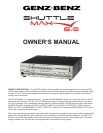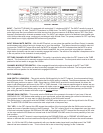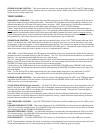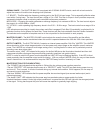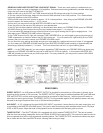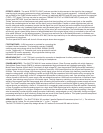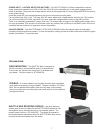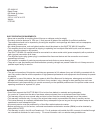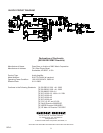
PREAMP VOLUME CONTROL – This control sets the volume of the preamp after the INPUT and FET channel gain
stages and before the EQ controls. Use this control in conjunction with the GAIN control and the MASTER VOLUME
control for your overall output level.
TUBE CHANNEL—
GAIN SWITCH (LOW/HIGH) – This switch sets the GAIN sensitivity for the TUBE channel. It works both like an Ac-
tive/Passive switch and like a GAIN boost switch. The amber LED indicates that the HIGH setting is selected. The
difference between the LOW and HIGH gain positions is approx. 10dB. Since there is a GAIN switch provided for
each channel this allows the player to set different gain structures for the FET or TUBE channels.
If warm, clean tube tone is desired, we recommend that the LOW setting be used for basses with hotter output or
active pickups (those with an output sensitivity over 1 Volt, generally most basses using one or two 9 volt batteries to
power their on board preamp) and the HIGH gain setting be used for basses with lower output or passive pickups.
If tube compression, growl, or all-out distortion is desired then the HIGH gain setting may be used regardless of the
pickup sensitivity. The ‘hotter’ the pickup output, the more tube distortion can be achieved.
PREAMP GAIN CONTROL – This control sets the input sensitivity gain of the 12AX7 TUBE preamp after the GAIN
switch. The design of the TUBE GAIN structure allows you to set your tone from rich, clean tube tone to mild tube
compression, to warm tube growl, to all-out aggressive tube overdrive. The volume of the signal is then controlled by
the TUBE PREAMP VOLUME control and also the MASTER VOLUME control. The higher the gain settings are, the
lower the channel volume will need to be set, so as not to overload the EQ network.
“O/L” LED – In the TUBE channel, this LED senses the condition of the input signal after the GAIN control and also
senses and warns of possible clipping in the EQ network. The “O/L” circuit does not sense distortion or overdrive in
the tube. Your ears are the best judge of that for your desired tone.
The “O/L” sensing circuit is very dependent upon the output of the bass instrument pickups, the GAIN and VOLUME
settings of the FET channel and the amount of EQ used i.e. the more radical the EQ boost and volume level of the
PREAMP VOLUME control, the more possibility of an overload condition.
If overloading of the TUBE channel is occurring, adjusting the PREAMP VOLUME and/or PREAMP GAIN controls
down will reduce or eliminate the over-load condition and adjusting the MASTER VOLUME control up will return the
overall loudness.
Note: It is OK for this LED to ash occasionally with your hardest notes played and it may ash even if the FET
channel has been selected for use. This is normal and is due to the Mixing topology for the 2 channels.
PREAMP VOLUME CONTROL – This control sets the volume of the preamp after the INPUT and TUBE gain stages
and before the EQ controls. Use this control in conjunction with the PREAMP GAIN control and the MASTER VOL-
UME control for your overall output level.
ACTIVE EQUALIZATION (both channels) – The SHUTTLE MAX 6.0 contains two active 4 band equalizers (one for
the FET and one for the TUBE channel) each with 2 sweepable parametric midrange frequency networks (low-mid
and high-mid) that offer 15dB of cut or boost with a bandwidth of approximately 1 octave wide. These are slightly
over-lapping lters to provide ultimate exibility.
Parametric lters are typically (but not always) used to reduce or remove offending frequencies in the instrument’s
pickup response, or boosting response to achieve a particular voicing. Spend some time experimenting so that the
process becomes creative as well as corrective.
LOW FREQUENCY CONTROL – The LOW FREQUENCY EQ section is an 80 Hz shelving curve with 15dB of cut or
boost.
LOW-MID FREQUENCY FILTER -- The center frequency of the LOW-MID lter is continuously user adjustable from
120 Hz to 2 KHz with a single control. The LOW-MID GAIN control sets the amount of level (cut or boost) for the spe-
cic frequency set by the LOW-MID FREQUENCY control.
HIGH-MID FREQUENCY FILTER -- The HIGH-MID frequency is continuously user adjustable from 300 Hz to 5 KHz
with a single control. The HIGH-MID GAIN control sets the amount of level (cut or boost) for the specic frequency
set by the HIGH-MID FREQUENCY control.
HIGH FREQUENCY -- The HIGH FREQUENCY EQ section is a 4 KHz shelving curve with 15dB of cut or boost.
NOTE: These equalizer networks are similar to those found on professional sound consoles and are very useful tools.
These active equalizers are very wide response type lters and a little “tweaking” goes a long way.
3



